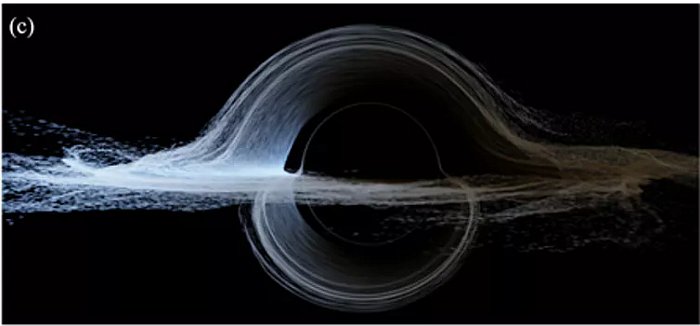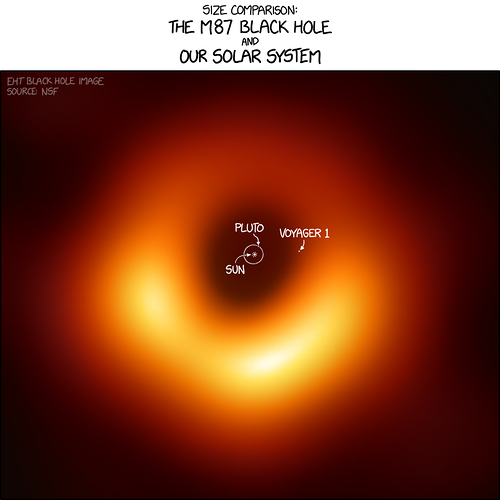Holy crap, it looks like they are ready to show us the results of all that data they’ve been processing for the past 2 years!!! They are holding SIX simultaneous press conferences in Washington, Brussels, Santiago, Shanghai, Taipei, and Tokyo to announce their findings. The main press conference at the National Press Club in Washington will be live-streamed and “extensive supporting audiovisual material” will be released at the same time.
i wonder what they are going to reveal  i am hoping for the secret to teleportation
i am hoping for the secret to teleportation
Actually really hype, thanks for the update.
I heard that they were releasing images of a black hole, but I didn’t realise it was this big. 13:00 next Wednesday, I’m at home so I’ll be watching. Thanks for tagging me!
Clues that Sgr A* is unusual, even for something as unusual as a supermassive black hole …
In 1978, astrophysicist Jean-Pierre Luminet used an IBM 7040 computer to simulate the appearance of a black hole with an accretion disk to an outside observer. He then plotted the results by hand (using ink and negative paper) to give the image below:
Almost 40 years later, physicist Kip Thorne used modern computers to simulate the same thing, resulting in an image that looks remarkably like the one Luminet created in the 1970’s:
Given that we now know Sgr A* had an accretion disk at the time of the EHT observations, will the images they release look like the simulation Luminet devised over 40 years ago??
[source: Science Alert]
(Thanks for the tag)
I wonder if Sgr A has any angular momentum (spin)
No doubt it does. All known stars rotate, so it would be expected that black holes formed by the collapse of very massive stars would retain the angular momentum of the progenitor star. Similarly, black holes formed by collisions would result in an object with some rotation.
The article I linked to a couple posts up highlights data suggesting that the axis of rotation of Sgr A* may be unusual in that it may not lie along the axis of rotation of the galaxy as a whole.
Dang, I can’t wait for the 10th!
Dang. I have work. It’s half-day for me, so I’ll immediately use that time in the afternoon to watch highlights, re-streams, and read as much as I can about what they revealed. I feel like we’re learning about something we’re not supposed to know abour or that we weren’t intented to have knowledge of - but yet, we’re pulling it off! Well, we’ll see what they give us. It is likely we’ll be left with more questions than answers!
So they’ve imaged the event horizon of the supermassive black hole at the heart of M87!
Their web site has more details:
Just … wow …
Here is a good video explaining how to visualise a black hole.
Some incredible facts about the image above:
- M87 is a supergiant galaxy – one of the most massive known
- M87 is 55 million light years away, meaning that the photons that were detected by the various radio telescopes that make up the EHT actually left the region around the black hole 54.5 million years before the first modern humans appeared on the scene
- the black hole at the center of M87 has a mass of between 3 and 5 BILLION Suns
- all that mass is contained within a volume with a diameter just slightly larger than our solar system
- the gas in the accretion disk (the orange “ring” in the image) is moving at up to 2 million miles/hour; the brightest parts of the disk are moving towards us, the dimmer parts are moving away
- the black hole itself is invisible, because it lies within a region where gravity is so strong that photons moving within it cannot escape the gravitational field
- the outer edge of that region is called the event horizon and is the dark “hole” in the center of the orange ring of the accretion disk
You may not have heard the name Katie Bouman before, but this is unlikely to be the last time you hear of this postdoctoral fellow from MIT (soon to be on the faculty at CalTech) who was instrumental in creating the black hole image. She developed one of the three image processing algorithms that were run in parallel to produce the final image. In April, a colleague captured her reaction as she watched the algorithm building the very first image of the ring.
If you’re interested in learning more about how the EHT team achieved what had previously been impossible, it’s well worth watching her TED talk from November 2016:
The black hole in M87 now has a name! It’s Pōwehi, which in Hawaiian means “embellished dark source of unending creation.” University of Hawaii professor Larry Kimura was asked by the EHT astronomers to suggest a name, and he drew inspiration from an 18th century chant called the Kumulipo, which tells the story of creation. The university released a video featuring Dr. Kimura discussing how he arrived at his choice:




